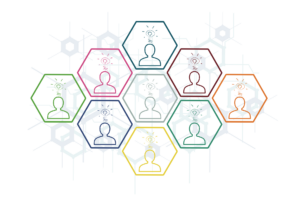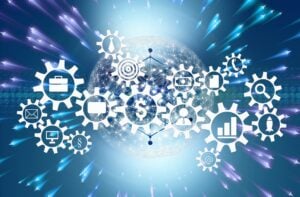The Application of AI
At its basic level, AI-driven innovation means the application of artificial intelligence technologies to the innovation process, as noted by Orchidea’s Emma Lahti in her blog, “What is AI driven innovation? Role of AI in innovation.” This could potentially involve AI algorithms, predictive analytics, natural language processing, and other machine learning techniques to generate new ideas, develop them further and support them with data findings, and improve decision making.
Of course, the combination of AI with human talent is also key in this innovation discovery process. We are not suggesting that AI should be unsupervised, so to speak. “AI-driven innovation is not about replacing human creativity but rather empowering it,” writes Lahti. Can AI create innovation? Well, AI certainly can leverage its vast amounts of data and knowledge base. Lahti points out that AI excels at combining, refining, and altering pre-existing ideas, as well as restructuring data.
But the potential is there to drive true innovation, as well as enhance the process to developing and generating ideas. Further, as Orchidea, an AI powered innovation platform, notes, “AI drives innovation through its diverse capabilities, particularly in analyzing data to make predictions, generate creative ideas, and offer suggestions for improvement. AI capabilities can be harnessed at various stages of the innovation process, including idea generation and development, concept prioritization, and evaluation. It can potentially elevate creativity and generate innovative ideas while providing valuable perspectives to human ideas.”
The Impact of AI
All Things Innovation’s “The Impact of AI on Innovation” further looked at this growing process. Artificial Intelligence (AI) is having a profound impact and influence on a broad range of industries. From healthcare to publishing to industrial fields and manufacturing, the effects of AI on systems and the workforce are just starting. Already there has been cause for celebration of automating some tasks, to consternation over what could be perceived as the negative effects of AI on a given field. Just where does one draw the line on the advantages versus the drawbacks? The technological developments of AI, and the rapid speed of adoption, are generating plenty of questions in the market. Just what are some of the pitfalls and potential of AI when it comes to innovation?
Looking forward to FEI 2024? The conference, which will be held June 10 to 12, will feature “Implementing An AI-Driven Innovation Discovery Process,” presented by Miranda Helmer, VP, Innovation Discovery, The Clorox Co., and Oksana Sobol, Senior Director, Insights Lead, The Clorox Co. No matter how it’s informed, the traditional innovation discovery process is simultaneously messy and beautiful. The messiness is provided by humans knocking their heads together to generate ideas that provide the groundwork for the growth and resilience of an organization. What’s beautiful is when that “fuzzy front-end of innovation,” works. But it works slowly. At this moment, the innovation discovery process simply needs to be AI-driven. Dive into this session and experience what’s already working, at the modern pace of business. Register for FEI 2024 here.
The Advantages of AI-Innovation
Implementing an AI-driven innovation discovery process can yield several significant benefits for organizations. We asked ChatGPT, appropriately enough, to list the top advantages:
- Efficiency and Speed: AI can rapidly analyze vast amounts of data, trends, and market insights, accelerating the innovation discovery process. This efficiency allows organizations to quickly identify opportunities, stay ahead of competitors, and bring new ideas to fruition faster than traditional methods.
- Data-Driven Decision Making: AI leverages data analytics to make informed decisions based on real-time information. By incorporating AI into the innovation discovery process, organizations can rely on data-driven insights, reducing reliance on intuition alone. This approach enhances the accuracy and relevance of decisions, leading to more successful innovation outcomes.
- Pattern Recognition and Trend Analysis: AI excels at recognizing patterns and analyzing trends across diverse datasets. Implementing AI in innovation discovery enables organizations to identify emerging patterns, consumer behaviors, and market trends that may not be apparent through conventional methods. This foresight helps in proactively addressing market demands.
- Enhanced Creativity and Idea Generation: AI tools can assist in brainstorming and idea generation by offering diverse perspectives and insights. These systems can analyze existing data to propose novel ideas, providing a valuable resource for teams engaged in innovation. This collaborative approach between humans and AI fosters a more creative and dynamic ideation process.
- Cost Reduction and Resource Optimization: The efficiency of AI-driven innovation discovery can lead to cost savings by streamlining processes, minimizing the need for extensive human resources, and preventing the pursuit of ideas with limited potential. This optimization allows organizations to allocate resources more effectively and focus on initiatives with higher innovation success probabilities.
- Continuous Learning and Adaptation: AI systems are capable of learning from ongoing data inputs and adapting to changing market dynamics. This adaptability ensures that the innovation discovery process remains relevant and aligned with evolving consumer preferences and industry trends over time, contributing to sustained success.
- Risk Mitigation: AI can assess potential risks associated with innovation initiatives by analyzing historical data and predicting potential challenges. This risk assessment enables organizations to make informed decisions, reducing the likelihood of failed innovations and optimizing resource allocation.
Harnessing Innovation
By harnessing the power of AI in innovation discovery, organizations can gain a competitive edge, foster a culture of continuous improvement, and adapt more effectively to the dynamic business environment. AI is further unlocking growth opportunities, which should only enhance the innovation environment, especially as AI continues to be integrated into a diverse range of industries. This increase in efficiency should be tempered with the challenges of AI, such as its input and output limitations, privacy and ethical concerns.
Back to the human equation for a moment. As Orchidea asks, “Can AI completely replace the human aspect of innovation management? While AI can generate cost-effective and creative ideas, human expert judgment remains challenging to replicate. Therefore, organizations must embrace AI as a valuable tool that empowers human creativity and decision-making. By adopting best AI practices and evaluating AI outputs with human effort, businesses can harness the full potential of AI in driving innovation.”
Video courtesy of Dell EMC
Contributor
-

Matthew Kramer is the Digital Editor for All Things Insights & All Things Innovation. He has over 20 years of experience working in publishing and media companies, on a variety of business-to-business publications, websites and trade shows.
View all posts




































































































































